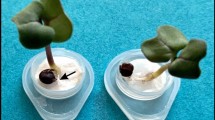Abstract
In a bioassay, the recovery of resting spore clusters ofPolymyxa betae from artificially infested sand was 1.7%. A recovery between 1 and 2% implies that one infective unit ofP. betae estimated with the most probable number method represented 50–100 resting spore clusters.
Neither prolongation of the duration of the bioassay from 6 to 18 weeks, nor a second and third 6-week replant resulted in a lower dilution endpoint of BNYVV in naturally infested soil. Estimates of inoculum potential of BNYVV were not significantly increased when incubation was extended over 6 weeks. In the 18-week bioassay, tap root weights showed a decrease with increasing inoculum levels. The presence of BNYVV in the tap root, as detected by ELISA, was associated with the presence of leaf symptoms and root browning.
Using the most probable number (MPN) method, assessment of vector and virus after 6 weeks yielded 3- and 16-fold higher MPNs, respectively, than when determined after 3 weeks. Prolongation of the bioassay to 12 weeks did not result in a higher MPN of BNYVV. Total and tap root fresh weight showed a decrease with increasing inoculum levels, but lateral root weight was hardly affected, after 3, 6 and 12 weeks of incubation.
Similar content being viewed by others
References
Abe, H. & Tamada, T., 1986. Association of beet necrotic yellow vein virus with isolates ofPolymyxa betae Keskin. Annals of the Phytopathological Society of Japan 52: 235–247.
Blunt, S.J., Adams, M.J.C. & Gilligan, C.A., 1991. Infection of sugar beet byPolymyxa betae in relation to soil temperature. Plant Pathology 40: 257–267.
Büttner, G. & Bürcky, K., 1991. Versuche und Überlegungen zum Nachweis des BNYVV im Boden mittels Fangpflanzen. Zeitschrift für Pflanzenkrankheiten und Pflanzenschutz 97: 56–64.
Clark, M.F. & Adams, A.N., 1977. Characteristics of the microplate method of enzyme-linked immunosorbent assay for the detection of plant viruses. Journal of General Virology 34: 475–483.
Cochran, W.J., 1950. Estimation of bacterial densities by means of ‘the most probable number’. Biometrics 6: 105–116.
Fujisawa, I. & Sugimoto, T., 1976. Transmission of beet necrotic yellow vein virus byPolymyxa betae. Annals of the Phytopathological Society of Japan 43: 583–586.
Gerik, J.S. & Duffus, J.E., 1988. Differences in vectoring ability and aggressiveness of isolates ofPolymyxa betae. Phytopathology 78: 1340–1343.
Keskin, B., Gaertner, A. & Fuchs, W.H., 1962. Über eine die Wurzeln vonBeta vulgaris Tournef. befallende Plasmodiophoracae. Berichte der Deutschen Botanischen Gesellschaft 75: 275–279.
Payne, R.W., Lane, P.W., Ainsley, A.E., Bicknell, K.E., Digby, P.G.N., Harding, S.A., Leech, P.K., Simpson, H.R., Todd, A.D., Verrier, P.J., White, R.P., Gower, J.C., Tunnicliffe Wilson, G. & Patterson, L.J., 1988. Genstat 5 Reference Manual. Clarendon Press, Oxford. 749 pp.
Steel, R.G.D. & Torrie, J.H., 1980. Principles and procedures of statistics. McGraw-Hill, New York. 663 pp.
Tamada T., Saito, M., Kiguchi, T. & Kusume, T., 1990. Effect of isolates of beet necrotic yellow vein virus with different RNA components on the development of rhizomania symptoms. Proceedings of the First Symposium of the International Working Group on Plant Viruses with Fungal Vectors, Braunschweig, Germany, August 21–24, 1990. Schriftenreihe der Deutschen Phytomedizinischen Gesellschaft. Band 1: 41–44.
Tuitert, G., 1990. Assessment of the inoculum potential ofPolymyxa betae and beet necrotic yellow vein virus (BNYVV) in soil using the most probable number method. Netherlands Journal of Plant Pathology 96: 331–341.
Tuitert, G., 1993. Effect of conditions during storage of infested soil on infection of bait plants byPolymyxa betae and beet necrotic yellow vein virus. Netherlands Journal of Plant Pathology 99: 291–301.
Tuitert, G. & Hofmeester, Y., 1992. Epidemiology of beet necrotic yellow vein virus in sugar beet at different initial inoculum levels in the presence or absence of irrigation: Dynamics of inoculum. Netherlands Journal of Plant Pathology 98: 343–360.
Tuitert, G. & Hofmeester, Y., Epidemiology of beet necrotic yellow vein virus in sugar beet at different initial inoculum levels in the presence or absence of irrigation: Disease incidence, yield and quality. European Journal of Plant Pathology (in press).
Author information
Authors and Affiliations
Rights and permissions
About this article
Cite this article
Tuitert, G., Bollen, G.J. Recovery of resting spores of Polymyxa betae from soil and the influence of duration of the bioassay on the detection level of beet necrotic yellow vein virus in soil. Neth. J. Pl. Path. 99 (Suppl 3), 219–230 (1993). https://doi.org/10.1007/BF03041411
Accepted:
Issue Date:
DOI: https://doi.org/10.1007/BF03041411




